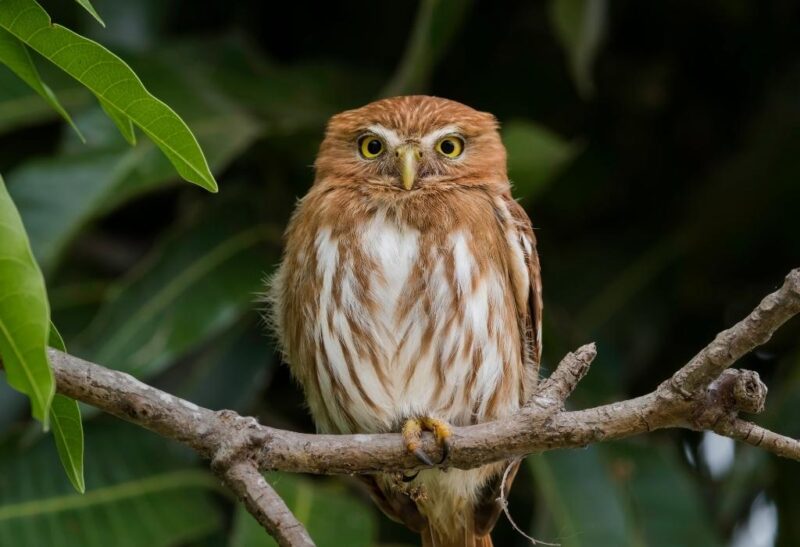Owls are birds of prey known for their hooting sounds, nocturnal natures, large eyes, and flexible heads. There are more than 200 species of owls found worldwide, with a considerable population inhabiting North America.
So, what are the different owls found in North America? There are a total of 18 owl species found in North America. This includes the boreal owl, snowy owl, spotted owl, northern pygmy owl, northern saw-whet owl, great horned owl, ferruginous pygmy owl, whiskered screech-owl, and more.
This article will provide you with detailed information about the different owl species in North America, including their appearance, place of origin, distinct characteristics, physical attributes, and food preferences.
Table of Contents
18 Owls in North America
Boreal Owl
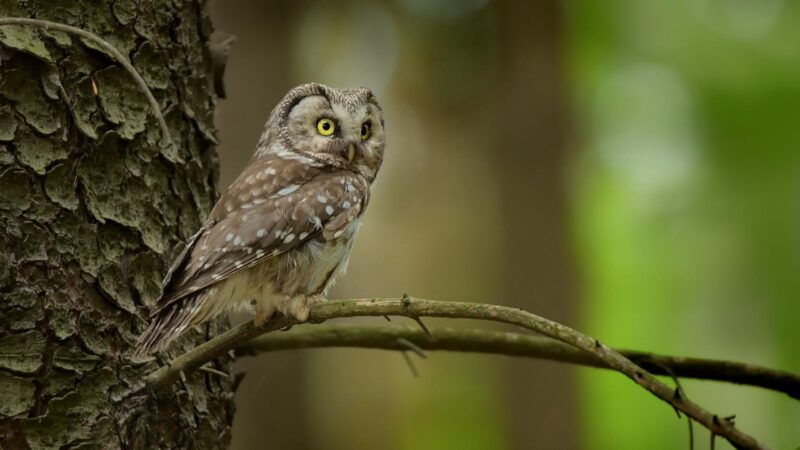
Boreal owls, also referred to as Tengmalm’s owls in Eurasia, are raptors that are highly dependent on trees for roosting, nesting, and hunting. They’re named after their preferred habitats: coniferous and mixed hardwood forests located in boreal climatic zones.
- Scientific Name: Aegolius funereus
- Appearance: They have large square-shaped facial discs with long wings and asymmetrical ears.
- Color: Grayish to dull white face with a black frame, white eyebrows and underparts, dark brown backs with light spots, black and brown mottled feathers on their heads, yellow eyes, and a light-colored beak.
- Lifespan: 3.4 to 16 years (wild)
- Size: 20 to 28 centimeters
- Weight: 93 to 215 grams
- Diet: Small mammals, preferably mice, voles, squirrels, chipmunks, insects, small birds
- Place Of Origin: North America, Northern Eurasia
- Characteristics: Solitary and migratory birds who communicate seldomly with other members except during breeding seasons. They can see well in the dark and detect prey through sounds.
Barred Owl
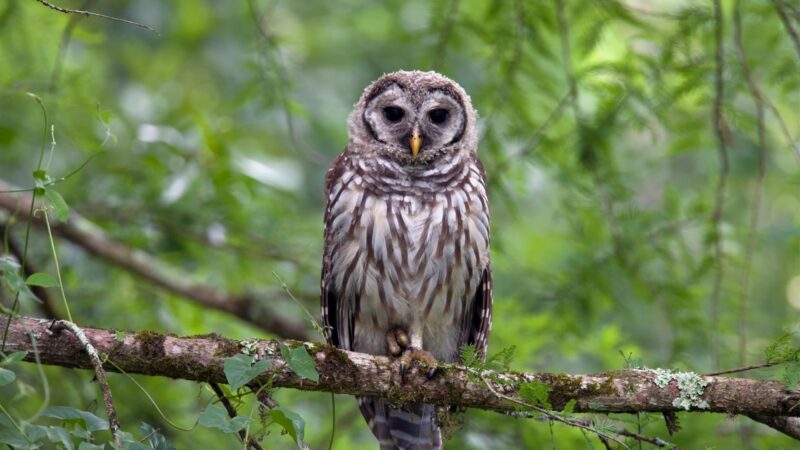
Highly vocal birds with hoots that are ventriloquial, or hard to locate, barred owls are located in forested and woodland habitats along bodies of water, specifically lakes, streams, swamps, and rivers. They’re known to hybridize with Northern Spotted Owls.
- Scientific Name: Strix varia
- Appearance: They have medium-sized bodies with stocky round-shaped heads, rounded tails, and no ear tufts.
- Color: Grayish brown body and plumage, grayish white facial discs, white underparts with dark streaks, brown eyes, and dull yellow beak
- Lifespan: Up to 18 years (wild)
- Size: 48 to 51 centimeters
- Weight: 630 to 800 grams
- Diet: Rabbits, rodents, grouse, fish, frogs, insects, snakes
- Place Of Origin: Eastern North America
- Characteristics: Solitary creatures unless it’s breeding season. They were originally nocturnal hunters but are now more active during the day.
Northern Hawk Owl
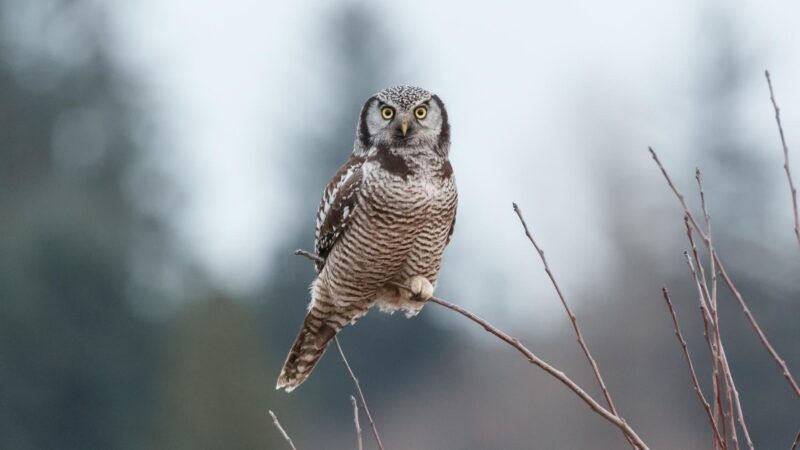
Considered skilled raptors, northern hawk owls adopt several hunting techniques such as perching and swooping, low contour flying, hovering over prey, and pursuit on the ground. They have hawk-like features, hence their names.
- Scientific Name: Surnia ulula
- Appearance: They are medium-sized oval-shaped owls with compact plumage, poorly-developed facial discs, no ear tufts, pointed tails and wings, and fully-feathered legs.
- Color: Dark brown bodies, white face with distinctive black borders, top of heads are brown dotted with white, and underparts are white with brown horizontal stripes.
- Lifespan: Up to 10 years (wild)
- Size: 36 to 45 centimeters
- Weight: 240 to 454 grams
- Diet: Moles, voles, mice, lemmings, shrews, rats, squirrels, grouse, ptarmigan, insects
- Place Of Origin: North America and Eurasia
- Characteristics: Active during the day but also hunts at night time by perching on trees to locate prey. They’re also known to maintain themselves through snow-bathing and preening.
Snowy Owl
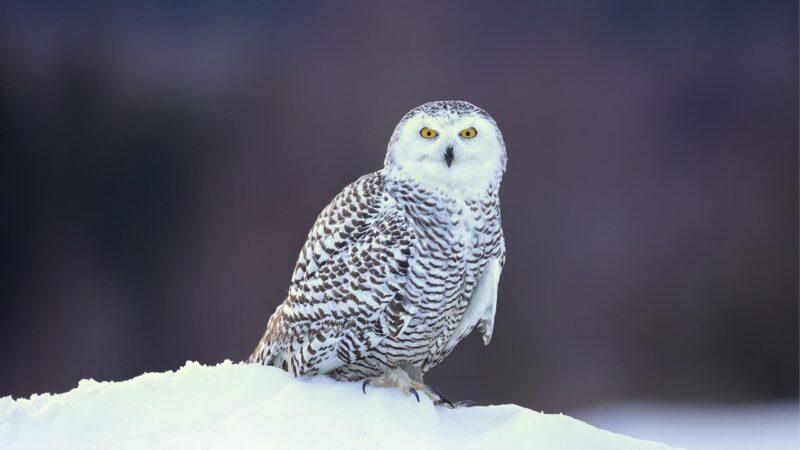
Snowy owls are found in open spaces and treeless areas during the winter season. They’re mistaken for lumps on snowy flat areas due to their regal white coloration. Unlike most owls, they’re extremely diurnal and prefer to hunt during daylight, especially in the summer.
- Scientific Name: Nyctea scandiaca
- Appearance: They have large and bulky bodies with smooth, rounded heads, hidden ear tufts, and dense plumage on the legs.
- Color: Dominantly white plumage with black or brown spottings on the body and wings and yellow eyes
- Lifespan: 9 years and 5 months (wild), Up to 28 years (captivity)
- Size: 63 to 73 centimeters
- Weight: 1.45 to 1.6 kilograms
- Diet: Primarily lemmings and mice, but they also eat rabbits, hares, seabirds, and fish
- Place Of Origin: North America
- Characteristics: They are territorial, solitary (except during breeding and when prey is abundant), and migratory.
Ferruginous Pygmy Owl
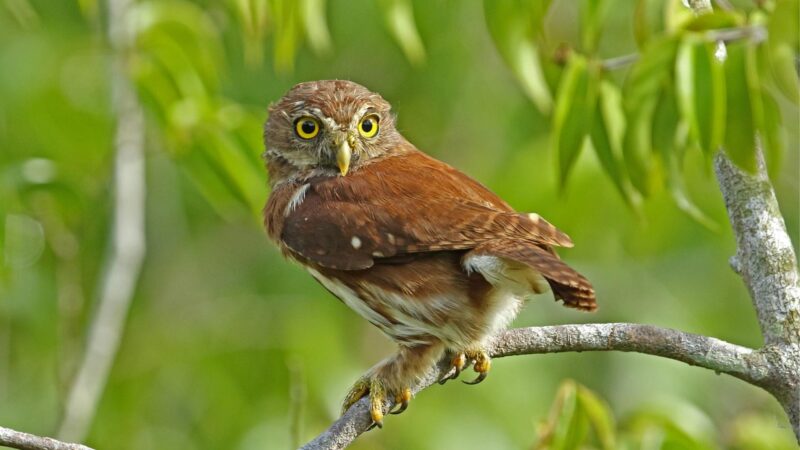
Often mistaken as a passerine, ferruginous pygmy owls can be heard hooting and twittering frequently around sunrise and sunset. Like most owls, they spend their time perching on trees. They move between and across trees by walking, hopping, and making short flights.
- Scientific Name: Glaucidium brasilianum
- Appearance: They are small in size, with rounded heads, no ear tufts, and long tails.
- Color: Rufous coloration with distinctive white streaks on its crown and barred with dark brown on the tail
- Lifespan: 6 to 7 years (wild)
- Size: 16.5 to 18 centimeters
- Weight: 62.4 to 76.5 grams
- Diet: Primarily insects, but they also eat birds, lizards, scorpions, and other small mammals.
- Place Of Origin: Southern and Central America
- Characteristics: Solitary but come in pairs during the breeding season and active during dawn and dusk.
Great Gray Owl
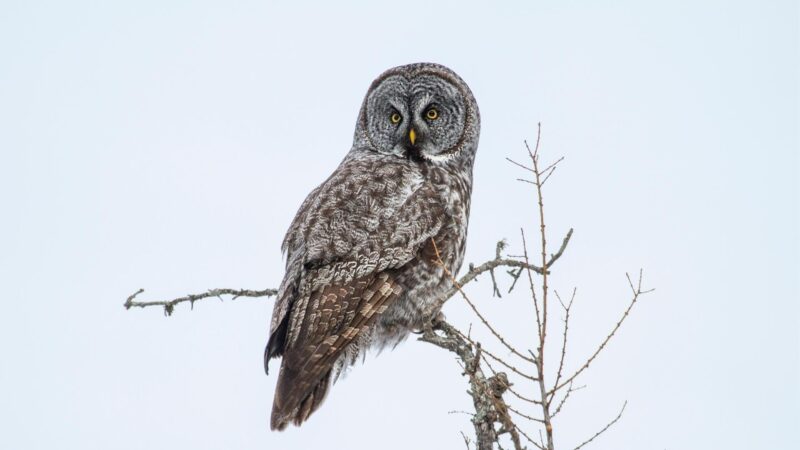
Great gray owls live primarily in boreal forests and montane meadows found in western mountains. They’re one of the tallest North American owls and are known for being extremely reclusive and quiet fliers. In fact, they even earned the nickname “Phantom of the North.”
- Scientific Name: Strix nebulosa
- Appearance: They are tall and large with a round head, no ear tufts, a distinct hooded facial disc, broad wings, and a long tail.
- Color: Silver gray bodies with gray, white, and brown streaking and barring all over. Facial discs have gray and brown concentric circles and a white bow tie-looking marking across the neck.
- Lifespan: Up to 18 years (wild)
- Size: 61 to 84 centimeters
- Weight: 790 grams to 1.45 kilograms
- Diet: Primarily pocket gophers and voles, but they also eat other small mammals such as mice, chipmunks, lemmings, and moles.
- Place Of Origin: North America
- Characteristics: Mostly sedentary but will leave their territories in search of food. They’re nocturnal birds, but they also hunt during the day.
Spotted Owl
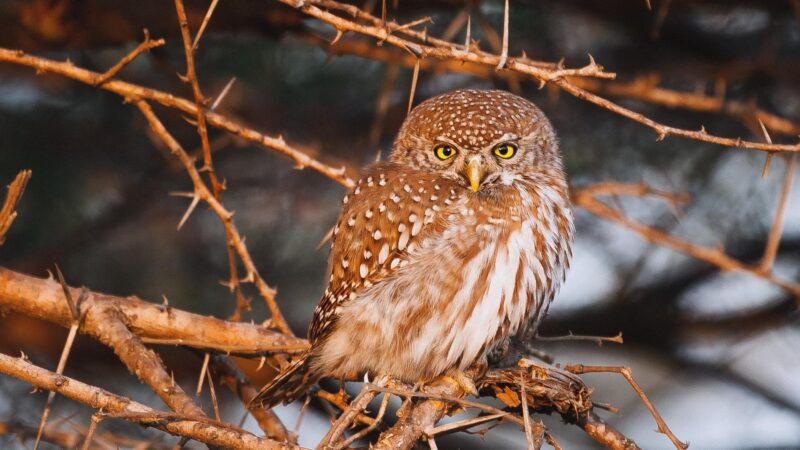
Known for being tame and uncaring around humans, spotted owls are rather difficult to find, but they inhabit mature coniferous forests with dense canopies and thick vegetation. They’re agile fliers with excellent maneuverability and capture prey using the perch-and-swoop strategy.
- Scientific Name: Strix occidentalis
- Appearance: They are large owls with round heads, no ear tufts, broad wings, and short tails.
- Color: Dark brown bodies with white oval-shaped markings on the chest and belly. Facial discs are dark brown in color with a distinct pale X-mark between the eyes.
- Lifespan: Up to 21 years (wild)
- Size: 45 to 48 centimeters
- Weight: 500 to 700 grams
- Diet: Primarily flying squirrels and woodrats but also eats other owl species, bats, mice, pocket gophers, hares, and insects.
- Place Of Origin: Western North America
- Characteristics: Solitary except when interacting with their mates and nestlings. They’re primarily sedentary but can travel short distances to adjust to changes in environmental temperature.
Burrowing Owl
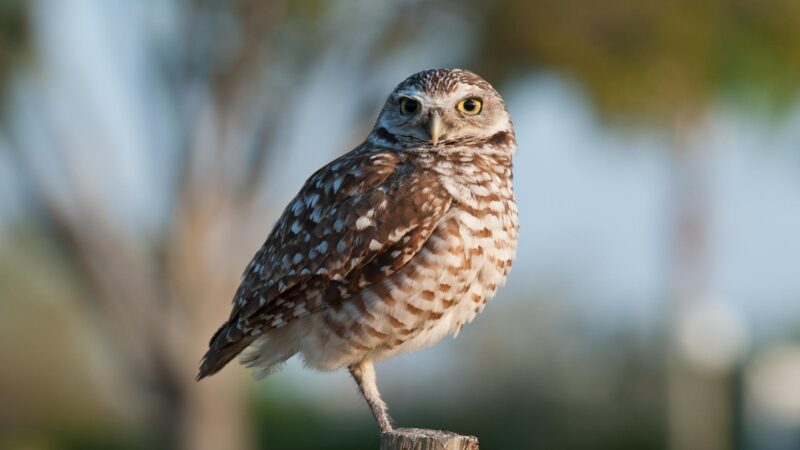
These ground-dwelling owls can be found in wide vegetative areas, especially in ground squirrel colonies and prairie dog habitats. Due to adaptation, they’re able to tolerate large amounts of carbon dioxide thanks to spending a lot of time underground.
- Scientific Name: Athene cunicularia
- Appearance: They are small owls with rounded heads, no ear tufts, long legs, and short tails.
- Color: Brown plumage with pale sandy-colored spots on its upper parts and barred with dark brown on the belly. They have yellow eyes, a bold white-colored throat, and eyebrows.
- Lifespan: 6 to 8 years (wild), Up to 10 years (captivity)
- Size: 19 to 25 centimeters
- Weight: 127 to 255 grams
- Diet: Insects such as beetles, crickets, and grasshoppers, small mammals such as ground squirrels and mice, sparrows, bats, earthworms, snakes, and lizards
- Place Of Origin: Midwest
- Characteristics: Diurnal, but hunting doesn’t start until sunrise and/or sunset. They spend their time preening, stretching, and perching.
Elf Owl
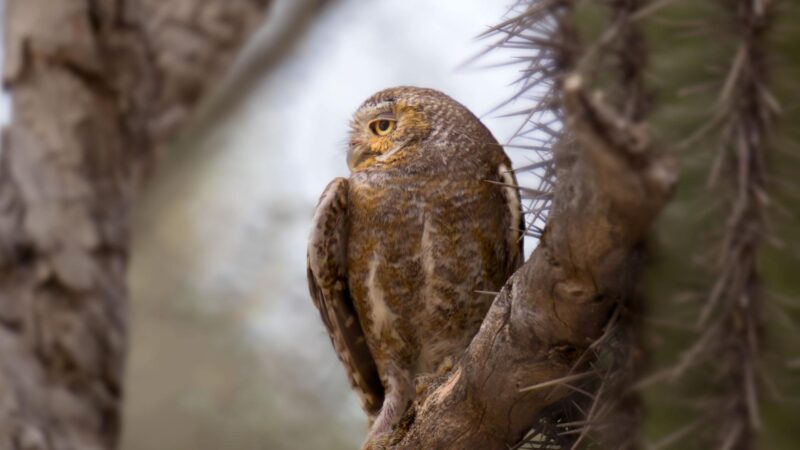
Known as the world’s smallest bird of prey with a size equating to that of a juice box, elf owls inhabit forests, upland deserts, and riparian woodlands. They’re only found during the summer season and can be identified by their yapping calls.
- Scientific Name: Micrathene whitneyi
- Appearance: They have tiny and compact bodies, no ear tufts, short tails, disproportionately large heads, and small feet.
- Color: Mottled with colors of gray, brown, rufous, and white. Facial discs are black-framed with white eyebrow marks and white spots on their wings.
- Lifespan: Up to 5 years (wild), Up to 14 years (captivity)
- Size: 12.4 to 14.2 centimeters
- Weight: 35 to 55 grams
- Diet: Insects, primarily beetles, moths, and crickets, also feed on small mammals and reptiles, especially lizards, kangaroo rats, and blind snakes.
- Place Of Origin: Southwestern United States and Mexico
- Characteristics: They are strictly nocturnal with both sedentary and migratory populations.
Northern Pygmy Owl
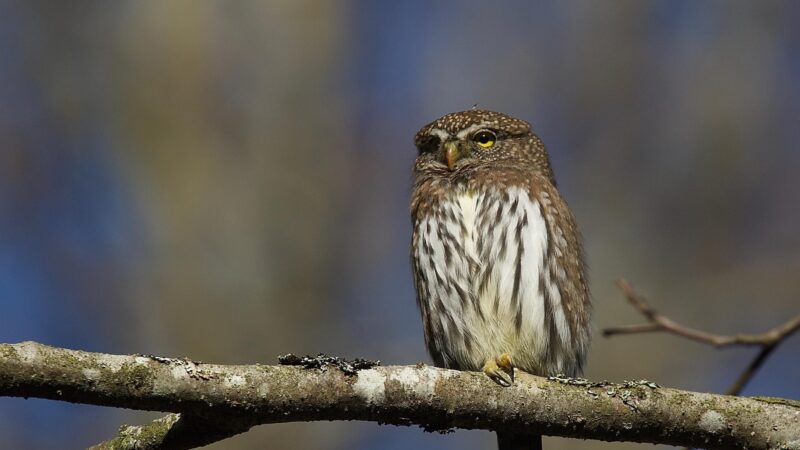
A small but ferocious hunter known for being predators to songbirds, northern pygmy owls are found in coniferous or deciduous forests and forest edges. They can also be found in suburban areas where they hunt for prey on bird feeders.
- Scientific Name: Glaucidium gnoma
- Appearance: They are small and compact-bodied birds with large circular heads, no ear tufts, long tails, and short rounded wings.
- Color: Brown plumage with white spots all over the head and back. Its most distinctive feature is two dark-colored eyespots that are rimmed with white, making it look like the owl has an extra pair of eyes.
- Lifespan: Up to 4 years (wild)
- Size: 16.5 to 18.5 centimeters
- Weight: 56 to 85 grams
- Diet: Mostly birds such as songbirds, jays, swallows, and chickadees but also feeds on mammals such as moles, shrews, and chipmunks.
- Place Of Origin: Central and North America
- Characteristics: Territorial, solitary (except during mating), and diurnal birds that heavily rely on vision to capture prey instead of hearing like most owls.
Eastern Screech-owl

Eastern screech owls are usually found when listening carefully to whinnies and trills as they vocalize during the night in woodland areas, parks, and suburbs. Gray morphs can camouflage in trees due to their coloration and pattern.
- Scientific Name: Otus asio
- Appearance: They have short and stocky bodies, large heads with imperceptible necks, rounded wings, short and squared tails, and pointed ear tufts.
- Color: Gray or rufous morphs, patterned with complex-colored bands and spots all over, and yellow eyes
- Lifespan: Up to 14.5 years (wild)
- Size: 16 to 25 centimeters
- Weight: 121 to 244 grams
- Diet: Moths, crayfish, mice, bats, earthworms, small birds
- Place Of Origin: Eastern North America, Canada, and Mexico
- Characteristics: Sedentary, territorial, and solitary except when mating
Western Screech-owl

Also excellent camouflaging birds as their eastern relatives, western screech owls can be found when listening to hollow but high-tooting noises in residential areas, urban parks, and the woods. They’re highly vocal regardless of the season and can be spotted all year round.
- Scientific Name: Otus kennicottii
- Appearance: They have small and stocky bodies, squarish heads, imperceptible necks, conspicuous feathered ear tufts, and short tails.
- Color: Brown, gray, or rufous bodies with white-flecked upper parts and pale breasts and bellies with dark spider-patterned streaks
- Lifespan: 1 to 13 years (wild), Up to 19 years (captivity)
- Size: 19 to 25.5 centimeters
- Weight: 163.5 to 183 grams
- Diet: Songbirds, flying insects, crayfish, fish
- Place Of Origin: North America and Northwestern Mexico
- Characteristics: They are nocturnal hunters, territorial, and mostly living in pairs but can be found in small groups.
Northern Saw-whet Owl

Smallest North American bird of prey is found in woodlands, coniferous forests, and even in rural and suburban areas. Its first line of defense is sitting still and not flying, which leads bird watchers to think they’re tame.
- Scientific Name: Aegolius acadicus
- Appearance: They have small but wide bodies with disproportionately large, rounded heads, no ear tufts, and heavily feathered feet and legs.
- Color: Brown birds that are mottled with white and also have white facial discs and white-spotted heads. They have pale-colored breasts streaked with brown.
- Lifespan: Up to 7 years (wild), Up to 16 years (captivity)
- Size: 18 to 21.5 centimeters
- Weight: 65 to 110 grams
- Diet: Primarily small mammals such as voles, deer mice, shrews, and lemmings. They also eat insects such as grasshoppers and beetles.
- Place Of Origin: North America
- Characteristics: They are nocturnal, solitary (except during mating season), and migratory birds.
Barn Owl
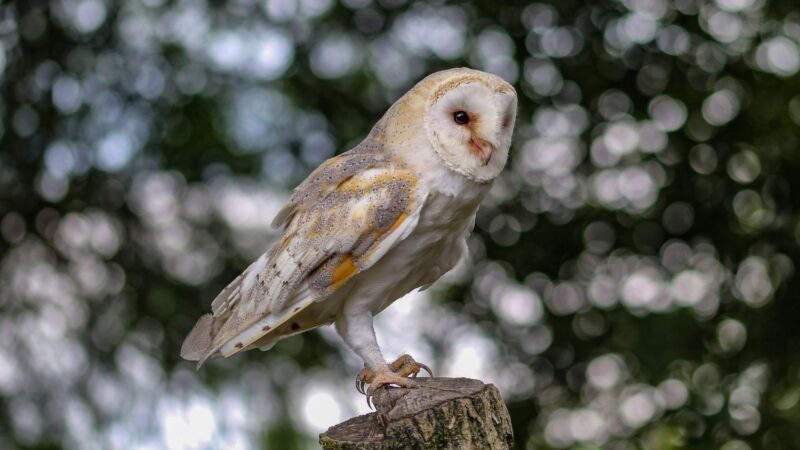
Inhabiting open habitats on every continent in the world except Antarctica, barn owls have populations that are the most widespread among all birds. They also have the most developed sense of hearing wherein they can locate prey with precision compared to other animals.
- Scientific Name: Tyto alba
- Appearance: They have medium-sized with smoothly rounded heads, no ear tufts, long rounded wings, long legs, and short tails.
- Color: Grayish white underparts with tiny black and white spots, light brown backs and heads, and white or light brown plumage
- Lifespan: Up to 34 years (wild)
- Size: 32 to 40 centimeters
- Weight: 430 to 620 grams
- Diet: Small mammals such as mice, lemmings, rats, shrews, rabbits, and bats. They also occasionally feed on birds such as meadowlarks and starlings.
- Place Of Origin: America and Eurasia
- Characteristics: They are either solitary or found in pairs, nocturnal hunters, and sedentary except for those populations living in the northern hemisphere.
Whiskered Screech Owl
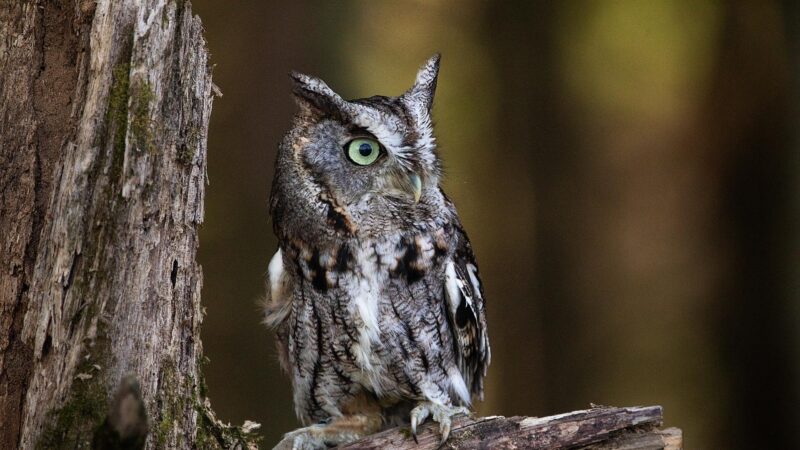
Found in pine-oak and montane woodlands, forests, and elevated forested areas, whiskered screech owls are relatively tame unless disturbed by unnatural stimuli. Their barred patterns allow them to camouflage on tree trunks while roosting during the daytime.
- Scientific Name: Otus trichopsis
- Appearance: They are small-sized owls with feathered toes, distinct whisker-like facial disc feathers, and prominent ear tufts.
- Color: Bodies are either gray, rufous, or brownish in color with yellow-olive bills and pale underparts that are bar-patterned.
- Lifespan: 3 to 7 years (wild)
- Size: 17.5 to 18.9 centimeters
- Weight: 85 to 98 grams
- Diet: Primarily large insects, but they also feed on mice, snakes, birds, shrews, and bats.
- Place Of Origin: North and Central America, Mexico
- Characteristics: Nocturnal, asocial except during breeding season, and territorial
Great Horned Owl
Great horned owls are soundless fliers, as they have modified flight feathers that muffle their wingbeats. They’re mostly found in the arctic tundra, open fields, woodlands, and even in rural and urban neighborhoods.
- Scientific Name: Bubo virginianus
- Appearance: Large and bulky bodies with two prominent ear-like feathered tufts, broad rounded wings, rounded heads, and short beaks.
- Color: Grayish brown bodies that are mottled, reddish brown faces, and a white patch on their throats
- Lifespan: 13 to 28 years (wild), 20 to 35 years (captivity)
- Size: 45.7 to 63.5 centimeters
- Weight: 910 grams to 2.5 kilograms
- Diet: Rabbits, skunks, rodents, insects, fish, reptiles, crustaceans
- Place Of Origin: North America
- Characteristics: Nocturnal and often perch on fence posts or tree limbs, territorial, sedentary (although some populations are nomadic), and solitary except during the mating season.
Long-eared Owl
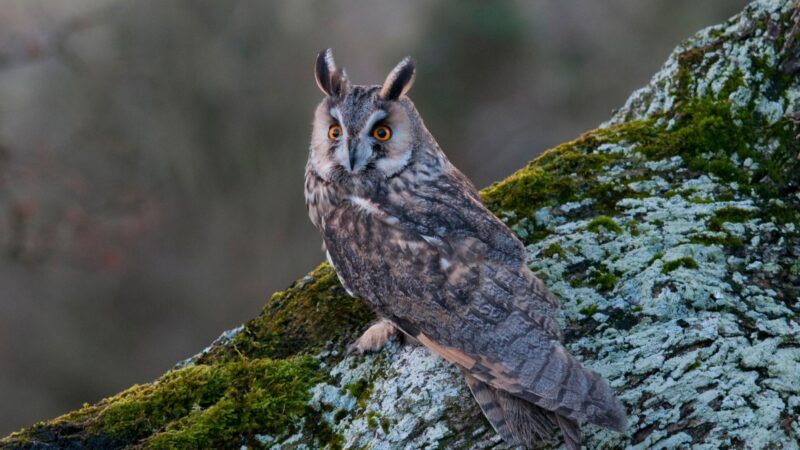
Long-eared owls have a variety of vocalizations, including hoots, barks, whistles, and squeals, that they usually use during the breeding season. Other than that, they’re generally silent birds. They live in grasslands, dense shrubs or trees, and open forests.
- Scientific Name: Asio otus
- Appearance: They have medium-sized and lanky bodies, narrow square-shaped heads, long and narrow facial discs, rounded wings, long tails, and long ear tufts.
- Color: Brownish gray plumage with vertical streaks, pale face patches, orange facial discs, and yellow eyes
- Lifespan: Up to 27.8 years (wild)
- Size: 35 to 40 centimeters
- Weight: 220 to 435 grams
- Diet: Primarily deer mice and voles but also feed on other small mammals such as pocket gophers, juvenile rabbits and rats, pocket mice, and shrews.
- Place Of Origin: North America, East Africa, and Eurasia
- Characteristics: Either migratory or nomadic and are exclusively nocturnal hunters that start hunting activities before sunset. They’re often in pairs during mating season, but they can also be seen in groups of 2 to 20 individual birds throughout the year.
Flammulated Owl
Found in mature mountain forests with brushy understories, flammulated owls are tiny birds that aren’t vocal but would occasionally give out twitters and hoots. Unlike most owls, they don’t have sexual dimorphism as both males and females are alike in size and appearance.
- Scientific Name: Otus flammeolus
- Appearance: They are small owls with short ear tufts, large rounded heads, and large eyes.
- Color: Have either gray or reddish morphs. The front parts of both morphs are blotched with black, reddish-brown, and gray. The back parts of the gray morphs are primarily gray, while it is reddish-brown for the reddish morph.
- Lifespan: Up to 7 years (wild)
- Size: 15 to 17 centimeters
- Weight: 50 to 65 grams
- Diet: They’re considered insectivores, primarily feeding on beetles, moths, and crickets.
- Place Of Origin: North America
- Characteristics: Nocturnal, territorial, and migratory owls
North America is home to 18 owl species of varying sizes, with the smallest owls being the Elf Owl and Northern Saw-whet Owls and the biggest being Great Gray Owls.
Most of them are nocturnal hunters, day roosters, and carnivores, but some show diurnal and insectivorous natures. Some are migratory, sedentary, and nomadic. Lastly, a great deal of these owl species is territorial.
Related: 8 Species of Owls in New Jersey | All You Need to Know!
List of Sources
Boreal Owl (Aegolius funereus). Alaska Department of Fish and Game.
Northern Pygmy-Owl. Alaska Department of Fish and Game.
Daw, S. (2020). Great Gray Owl. National Park Service – U.S. Department of the Interior.
Hayward, G. D. (1994). Chapter 9. Review of technical knowledge: Boreal owls. Forest Service – U.S. Department of Agriculture.
Great Horned Owl. Tennessee Wildlife Resources Agency.
